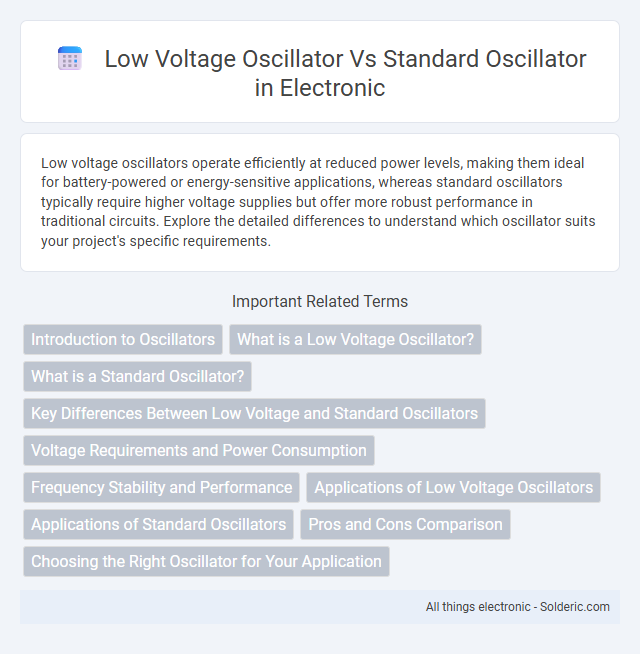Low voltage oscillators operate efficiently at reduced power levels, making them ideal for battery-powered or energy-sensitive applications, whereas standard oscillators typically require higher voltage supplies but offer more robust performance in traditional circuits. Explore the detailed differences to understand which oscillator suits your project's specific requirements.
Comparison Table
| Feature | Low Voltage Oscillator | Standard Oscillator |
|---|---|---|
| Operating Voltage | Typically 1.2V to 3.3V | Typically 3.3V to 5V |
| Power Consumption | Low power usage, optimized for battery operation | Higher power consumption relative to low voltage types |
| Frequency Range | Commonly 1 kHz to 50 MHz | Wide range, often up to hundreds of MHz |
| Application | Wearables, portable devices, IoT | General-purpose electronics, industrial applications |
| Signal Stability | Good stability optimized for low voltage | Higher stability, suitable for precision timing |
| Cost | Typically lower cost due to simpler design | Often higher due to enhanced features |
Introduction to Oscillators
Low voltage oscillators operate efficiently at reduced power levels, making them ideal for battery-powered and energy-sensitive applications. Standard oscillators typically require higher voltage levels, offering stable frequency generation in general-purpose electronic circuits. Both types serve essential roles in timing, signal generation, and frequency control across communications, computing, and embedded systems.
What is a Low Voltage Oscillator?
A Low Voltage Oscillator (LVO) operates efficiently at reduced power supply levels, often below 3.3 volts, making it ideal for battery-powered and low-energy devices. Unlike standard oscillators that require higher voltage inputs, LVOs minimize power consumption without sacrificing frequency stability, enhancing the performance of wearable electronics, portable sensors, and IoT applications. Your choice of oscillator impacts device longevity and reliability, especially in energy-sensitive environments.
What is a Standard Oscillator?
A standard oscillator is an electronic circuit designed to generate a periodic waveform, typically used as a timing reference in various devices. It operates at conventional supply voltages, usually around 3.3 to 5 volts, providing stable frequency output ideal for clocks, radios, and microcontrollers. Compared to low voltage oscillators, standard oscillators prioritize signal stability and amplitude over power consumption, making them suitable for applications with ample power availability.
Key Differences Between Low Voltage and Standard Oscillators
Low voltage oscillators operate efficiently at reduced power supply levels, making them ideal for battery-powered and portable devices, whereas standard oscillators typically require higher voltage for operation, offering more stable frequency output and broader application range. Key differences include power consumption, with low voltage oscillators minimizing energy usage, and frequency stability, where standard oscillators generally provide superior precision due to higher voltage operation. Your choice depends on application requirements, balancing energy efficiency against performance stability.
Voltage Requirements and Power Consumption
Low voltage oscillators operate efficiently at reduced voltage levels, typically ranging from 1.2V to 3.3V, resulting in significantly lower power consumption compared to standard oscillators that often require 5V or higher. This reduced voltage requirement enables your electronic devices to achieve longer battery life and enhanced energy efficiency, especially critical in portable and low-power applications. By choosing a low voltage oscillator, you optimize performance while minimizing heat generation and overall power draw in your circuit designs.
Frequency Stability and Performance
Low voltage oscillators offer improved frequency stability under varying power conditions, making them ideal for battery-powered or energy-sensitive applications. Standard oscillators typically provide higher performance with precise frequency accuracy but require stable voltage inputs, limiting their use in fluctuating environments. Your choice depends on whether consistent power supply or energy efficiency is the critical factor in oscillator performance.
Applications of Low Voltage Oscillators
Low voltage oscillators are essential in battery-operated devices, wearable technology, and portable medical equipment due to their reduced power consumption and extended battery life. Their applications extend to low-power wireless communication systems and IoT devices where minimizing energy usage is critical. Unlike standard oscillators, low voltage oscillators enable continuous operation in energy-sensitive environments, making them ideal for modern electronics requiring efficient power management.
Applications of Standard Oscillators
Standard oscillators are widely used in communication systems, including radio transmitters and receivers, where stable frequency generation is critical for signal integrity. They also play a key role in digital clocks and microcontroller timing circuits, providing precise timing references for accurate operation. Industrial automation and instrumentation frequently rely on standard oscillators for control system synchronization and sensor signal processing.
Pros and Cons Comparison
Low voltage oscillators offer reduced power consumption, making them ideal for battery-powered and portable devices but typically have lower output signal amplitude and can experience higher phase noise compared to standard oscillators. Standard oscillators provide stable frequency output with higher signal strength and better noise performance, suitable for precision applications, but consume more power and generate more heat. Choosing between the two depends on the trade-off between energy efficiency and signal stability required by the specific electronic design.
Choosing the Right Oscillator for Your Application
Low voltage oscillators operate efficiently at reduced power levels, making them ideal for battery-powered and portable devices where energy conservation is critical. Standard oscillators offer broader frequency stability and higher output drive capabilities, suitable for applications demanding precision and robust performance. Selecting the right oscillator depends on balancing power consumption requirements with frequency accuracy and output needs specific to your application's operational environment.
Low voltage oscillator vs Standard oscillator Infographic

 solderic.com
solderic.com